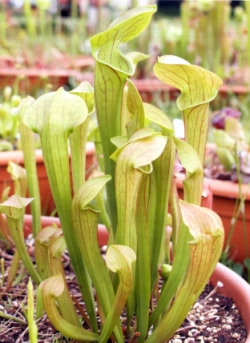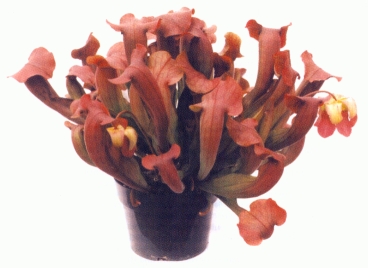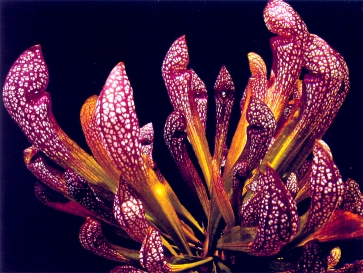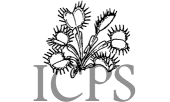|
Carnivorous Plant Newsletter
Volume 32, Number 1, March 2003, pages 24 - 27; Front Cover
NEW CULTIVARS
Sarracenia 'Chas' Brew'
Sarracenia 'Cobra Nest'
Sarracenia 'Scarlet Belle'
Sarracenia 'Chas' Brew'
Submitted: 20 July 2002
Sarracenia ‘Chas’ Brew’ is a Sarracenia oreophila
x Sarracenia rubra subsp. wherryi cross that is
a vigorous grower, and which rapidly produces new pitchers and crowns
throughout the growing season. Pitchers are 15-20 cm (6-8 inches)
at maturity with physical features typical of both parents. Lid
morphology is convex and triangular when viewed from above. Further,
the width, length, and height of its lid is uniquely large 5 cm
(2 inches) relative to the 2.5 cm (1 inch) diameter pitcher opening.
Also noteworthy, the lid tilts slightly upward from the horizontal
and the pitcher opening tilts slightly downward from the horizontal.
This feature gives Sarracenia ‘Chas’ Brew’
significant exposure to the inside of the pitcher. The entire pitcher
has a pale yellow/green background with an orange lid in full sunlight.
There is bold venation throughout the pitcher and lid, both internally
and externally, similar to many clones of Sarracenia oreophila.
Flowers have pale yellow petals without noticeable fragrance. Vegetative
propagation is necessary to maintain the unique features of this
hybrid.
The cross resulting in this plant was performed by Charles Brewer.
The cultivar name (‘Chas’ Brew’) is a pun on Charles’
name.
CHARLES BREWER • VA • USA
STEFAN PLOSZAK • NC • USA

Front Cover: Sarracenia 'Chas' Brew'. Photograph by Stefan Ploszak.
Sarracenia 'Cobra Nest'
Submitted: 3 September 2002
Booman
Floral announced the introduction of the world’s first patented
carnivorous Sarracenia hybrid, named Sarracenia
‘Cobra Nest’. The United States Patent office granted
propagation protection to this new cultivar on August 6, 2002. Sarracenia
‘Cobra Nest’ is the first plant that was bred and selected
to be easy to grow for consumers, and suitable for pot plant production
by commercial growers. The fanciful name refers to the thick cluster
of snake leaf traps.
This cultivar earned its patented status for its unique horticultural
characteristics. It grows vigorously, year around, in a compact
shape, about 25 cm (10 inches) tall. This is in contrast to many
wild species, which turn brown in the Fall and go dormant. A flaring
hood reflexes over the top of the hollow tube leaf. While ornamental,
it is also a practical feature as it prevents leaf collapse when
water or rain hits the plant from above.
Sarracenia ‘Cobra Nest’ is slightly more
resistant to leaf edge browning from salt or fertilizer burn when
compared to many wild species. Leaf traps open green, then turn
red and maroon as they mature. The plant branches very freely, which
gives it a full thick appearance, much appreciated by customers.
Flowers are large with pink pendant petals, and white sepals, appearing
after one year, in the summer.
Sarracenia ‘Cobra Nest’ is a hybrid that
resulted from a six year collaborative breeding and selection program
between me (Booman Floral), and Dr. Larry Mellichamp (University
of North Carolina at Charlotte). Hundreds of thousands of seedlings
were grown and evaluated during the selection process. The exact
parentage of Sarracenia ‘Cobra Nest’ is unknown.
Developing commercially viable cultivars helps preserve the plants
in the wild. Housing developments, pine plantations, and farming
have encroached upon or destroyed most Sarracenia habitats.
Poachers have wiped out many Sarracenia as well. By creating new
cultivars that actually grow better for consumers and by growing
them in nurseries, we hope to protect the remaining wild populations.
JAMES L. BOOMAN • Vista, CA • USA

Figure 1. Sarracenia 'Cobra Nest'. Photograph James L. Booman.
Sarracenia ‘Scarlet Belle’
Submitted: 15 November 2002
Sarracenia
cultivars can be found naturally, but the best are planned and then
created by combining the best traits of two plants. Rather than
just pairing two random plants and hoping for the best (which is
usually a waste of time, energy, and resources), hybridizers plan
and design characteristics into the final product. Such engineering
resulted in Sarracenia ‘Scarlet Belle.’
I was growing and selling plants for the retail and wholesale carnivorous
plant trade via WIP (World Insectivorous Plants, circa 1976-1990)
when I developed the hybrid cultivar that is finally being named
Sarracenia ‘Scarlet Belle’. It was one of two
plants that I wanted to produce for collectors and the wholesale
market. I sought to offer a Sarracenia that would exhibit
the best of the genus by having a striking combination of vivid
colors, as well as being a plant that would grow rapidly, perform
well in shade or bright sun, tolerate soil moisture levels ranging
from very wet to almost dry, maintain a compact form for easier
and less destructive transport, and have an abundance of firm, long
lasting, and intriguingly shaped pitchers. I was able to develop
this showstopper by combining S. leucophylla and S.
psittacina parents that fully met my design criteria. Only
the single best plant from the progeny was selected for tissue culture
replication.
Sarracenia leucophylla is noted as one of the best species
of the genus for coloration and form. It has two pitchering seasons,
and grows well in wet or semi-dry open savannas. Unfortunately for
my target goal, it is a rather tall species, and mature plants only
produce a few pitchers at a time. Its counterpart for this pairing,
Sarracenia psittacina, is a colorful low-growing rosette
that prefers wet to soggy habitats. While S. psittacina
plants can be found naturally in open locations, they seem to be
more at home and are typically found in shady areas under shrubs
or between tall grasses. One very desirable feature of this species
is its propensity to produce an abundant quantity of pitchers that
retain their color during the normal winter dormancy period.
Sarracenia x wrigleyana (S. psittacina x leucophylla)
is an uncommon, but naturally occurring hybrid periodically found
in Gulf Coast savanna bogs containing both parent species. I believe
that the majority of Sarracenia x wrigleyana plants result
from crosses where the maternal parent is S. psittacina.
This is because Sarracenia are protogynous, meaning the
stigmas are mature and able to receive pollen before the stamens
release pollen. Because of this, a Sarracenia flower is
most likely to be pollinated by other flowers that matured earlier
in the season. This aspect also serves to minimize self-pollination.
Since S. leucophylla plants typically flower four to six
weeks earlier than S. psittacina, natural crosses between
these two plants are more likely to involve a slightly late-blooming
S. leucophylla (pollen parent) and a slightly early-blooming
S. psittacina seed parent. As further evidence for my theory,
most of the wild S. x wrigleyana plants I have observed
were near a group of S. psittacina plants. I believe this
indicates the seeds germinated directly from or near the seed parent,
i.e. S. psittacina.
I wondered what the characteristics of S. x wrigleyana
would look like if the parentage was reversed, i.e. if a S.
leucophylla was the seed parent. From a production standpoint,
S. leucophylla is a superior seed parent as it produces
considerably more seed in the capsule than its counterpart. This
aspect was important before the establishment of tissue culture
reproduction for Sarracenia. Seed was the only viable means
at that time to generate wholesale quantities of plants.
In the spring of 1985, I removed pollen from a very compact and
maroon colored S. psittacina and used it to pollinate a
number of crimson red S. leucophylla plants. Seed was harvested,
cleaned, refrigerated, and stratified for sowing the following year.
Plants were raised and then sold locally or exported to CRESCO,
a major European carnivorous plant distributor at that time. I eventually
stopped selling plants on a retail and wholesale level, but retained
a few dozen of the most outstanding plants for my personal collection.
It seemed that everyone who saw this particular hybrid wanted one.
In retrospect, I should have attempted propagation by using the
proven leaf extraction method that was used on rare forms of S.
psittacina. I would simply pull off a full leaf or pitcher
with some of the rhizome tissue, insert the bottom 3 cm into semi-moist
chunky grade vermiculite, and enclose it in a humid terrarium. Roots
would begin to form within four to six weeks. This vegetative propagation
method might work on S. x wrigleyana because of its S. psittacina
parentage.
A few years ago, I provided my best S. x wrigleyana plant
to AgriStarts for consideration as an addition to their expanding
carnivorous plant line. Mike Rinck was impressed with the sample
and its pitcher retention during the winter months. He put the hybrid
into AgriStarts’ intensified tissue culture production program
and it is now being sold in wholesale lot quantities.
Our son, Brian Hanrahan and his fiancée, Jennifer Kruse,
selected the name ‘Scarlet Belle’ on August 7, 2002.
I bestowed this honor on them as an endearing reminder of their
wedding the following week. Jennifer is a “Belle” from
Texas who incidentally selected a scarlet red color scheme for her
wedding. These two facts, coupled with the plants natural coloration
and “horn” or “bell” shaped pitchers, solidified
the name selection.
Sarracenia ‘Scarlet Belle’ grows well in
wet to semi-moist standard Sarracenia mixes. Coloration
is best under full sun, but the plant tolerates and develops nice
colors with lower light levels. It maintains pitchers throughout
the year with some degradation in the winter months; growth spurts
occur in the spring and late summer. It differs from typical S.
x wrigleyana with its intense scarlet red pitchers and vigorous
habit that produces a profusion of pitchers. The pitchers are up
to 40 cm long, slightly conically tapered, with the mouth turned
toward the center of the plant; the mouth opening is variable in
aperture, from being totally closed to 5 cm wide x 3 cm high on
mature pitchers and flared triangular in shape; prominent areoles
descend decreasingly from the pitcher’s mouth. All parts of
the flower perianth are deep burgundy red; the size is intermediate
between S. leucophylla and S. psittacina.
Older pitchers can be removed to stimulate new growth and to maintain
the plant’s esthetic balance. Reproduction should be done
only vegetatively, i.e., by tissue culture, rhizome division, and
leaf cuttings (if it works!).
BOB HANRAHAN • Powder Springs, GA • USA

Figure 2. Sarracenia 'Scarlet Belle'. Photograph by Michael Hunt.
|

